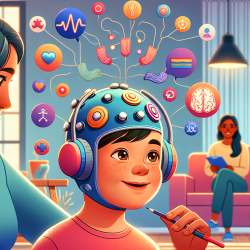Introduction
In the realm of speech-language pathology, the intersection of autism spectrum disorder (ASD) and specific language impairment (SLI) presents a complex challenge. A recent study titled "Can EEG Correlates Predict Treatment Efficacy in Children with Overlapping ASD and SLI Symptoms: A Case Report" explores the potential of electroencephalography (EEG) as a tool to predict treatment outcomes in children with these overlapping symptoms. This blog delves into the findings of this study and discusses how practitioners can leverage these insights to improve therapeutic interventions.
Understanding the Research
The study followed a child with overlapping ASD and SLI symptoms over a period of 30 months, assessing various developmental functions through behavioral tests and EEG recordings. The primary aim was to determine whether EEG correlates of auditory-verbal processing could serve as indicators of treatment efficacy, especially in cases where behavioral tests fail to show significant progress.
Key findings from the study indicated a strong correlation between EEG measures, particularly the theta rhythm in the frontal regions, and improvements in cognitive, speech-language, and sensory functions. This suggests that EEG can be a valuable tool in predicting and assessing treatment efficacy in children with ASD and SLI.
Implications for Practitioners
For practitioners, these findings underscore the importance of incorporating EEG assessments into therapeutic protocols for children with ASD and SLI. Here are some practical steps to consider:
- Integrate EEG Monitoring: Use EEG to monitor neural changes during therapy. This can provide objective data on treatment progress and help tailor interventions to individual needs.
- Focus on Early Intervention: The study highlights the significance of early and continuous integrative therapy. Initiating treatment during critical developmental periods can enhance neuroplasticity and improve outcomes.
- Collaborate with Multidisciplinary Teams: A holistic approach involving psychologists, neurologists, and speech-language pathologists can optimize treatment plans and address the multifaceted needs of children with ASD and SLI.
Encouraging Further Research
While this study provides promising insights, further research is needed to validate these findings across larger populations. Practitioners are encouraged to participate in or initiate studies that explore the utility of EEG in various therapeutic contexts. Such research can contribute to a more nuanced understanding of the neural mechanisms underlying ASD and SLI and inform the development of more effective interventions.
Conclusion
The integration of EEG into therapeutic practices for children with ASD and SLI holds great potential for enhancing treatment efficacy. By leveraging data-driven insights, practitioners can make informed decisions that lead to better outcomes for children. As we continue to explore the intersection of neuroscience and speech-language pathology, the possibilities for improving the lives of children with neurodevelopmental disorders are vast.
To read the original research paper, please follow this link: Can EEG Correlates Predict Treatment Efficacy in Children with Overlapping ASD and SLI Symptoms: A Case Report.










